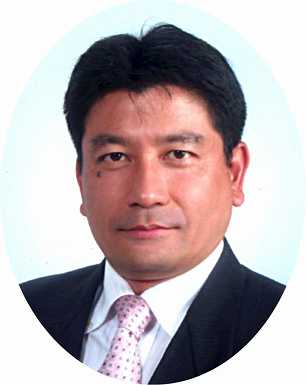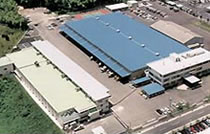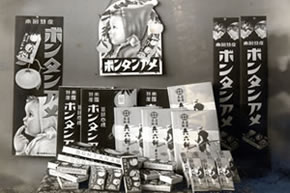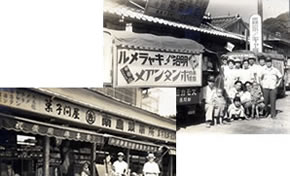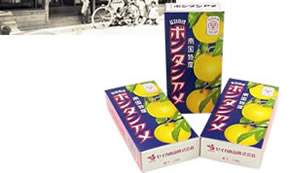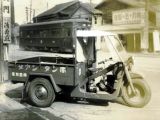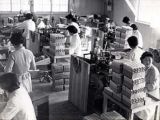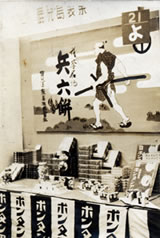The long-nosed goblin's secret recipe
- Bontan Ame 1924 -
|
Our business has not always been in good shape. The first crisis came in 1924. Sales of glutinous starch syrup dropped sharply, and this was the main line of our business at the time. Furthermore, an accident occurred during transport of our syrup to destinations outside the prefecture. The tin cans on board a transportation ship developed holes from which the syrup spilled out. We pressed the freight company for compensation, but the company ended up billing us for the cost of cleaning the deck instead of paying damages. This was a blow The situation we were in was so bad that the company could have gone bust. But Sohjiro (the first President) overcame the crisis with flying colors by inventing Bontan Ame. He came up with the idea for Bontan Ame when he saw factory workers playfully cutting Chosen Ame, made from glutinous starch syrup, into small pieces. Sohjiro added color and flavor and put the bite-sized candies into a paper box in the way that caramel is. He hired a designer in Osaka for the package design. Some described the design as unpolished, but many others liked it for the bold, tropical colors. All that was left was advertisement to impress people with the catchphrase 'the long-nosed goblin's secret recipe'. An advertising crew was hired and sent to many parts of the country. They were dressed like Satsuma Samurais with the battle surcoat on and the long battle flag sticking out from their backs with Bontan Ame printed on it. In Okinawa, they entered the red-light district by accident. They were surrounded and confronted by women working there and ran away, leaving their flags on the spot. Sohjiro planned another advertisement campaign in 1928. He said he was going to buy an aircraft retired from service and use it to drop Bontan Ame from the sky. The plane was priced at 5000 yen and pilots were hired. A big send-off party was held at Kakumeikan for the advertisement and general affairs managers leaving for Tokyo to take the plane. The party made headlines with photos, and the campaign was widely discussed. However, it was never carried out. The two managers were waiting in Tokyo for the five thousand yen to arrive, but the money did not come. The company was short on cash due to a recession. A telegraph was sent to the managers to tell them to return to Kagoshima. Some said Sohjiro had never intended to carry out the campaign in the first place and it had been an advertisement tactic. Sohjiro said, "I had the intention, but at the end of the day, it did not matter whether we flew the plane or not because it had the same effect and caught attention." He had a big heart and laughed off the charge. (excerpts from a Kagoshima Shinpo article) |
Memories of the War 1945
|
Kagoshima City was in utter ruins. I decided to close the factory because it had burned down. I went to the site of the burned factory and wrote down with charcoal the day and time of an emergency meeting. I think it was August 20th when the meeting took place and many gathered. On that day, I removed account books and bankbooks from the burned safe. They were intact. I had placed inside the safe a bottle of water to prevent the valuables form catching fire. Most of the water inside the bottle had evaporated. I told the employees when to come to collect their salaries and severance payment. After I had paid them out, a load was taken off my mind. I did not care if I had to die because I had done what I had to do…The war was over. The next day, I left the place I was staying to avoid air raids caught the first train and went to Kagoshima City. The downtown was a disaster. The devastation was so complete that I could see Nishi Station from Kagoshima Station because there was nothing in between to obstruct the view. Ninety-nine percent of the buildings in Kagoshima City were destroyed by fire. I went to the site of the burned factory and began rebuilding the office to restart business. I recovered timber, half-burned galvanized iron sheets and nails from air-raid shelters. It took me two days to build an 8.25m2 shack. I did not have a shaving plane, but I did have a saw and a hammer at the place I was staying during the war. The small shack standing alone in the ruins was the place where we took the first step forward toward recovery. |
Hyoroku Mochi and the definition of underwear 1949
|
I was not sure whether to launch Hyoroku Mochi in the market because, at the time, morale-inspiring movies and plays were forbidden by GHQ. I thought it would be a disaster if the product was banned after its debute. So I went to the police first and was told the sword Hyoroku had with him would be problematic. I took the advice seriously. I went to the U.S. military administration office and told the Hyoroku story through an interpreter to the officer in charge. I argued that it was not a samurai story but a funny story. I told them that in old days all samurais had a sword with them and it was part of their life style back then. The officer said, "I understand. The sword is OK, but the man's bottom is uncovered. That's a problem. I will give you permission if you make him wear underwear." I was surprised, but I had to counter-argue. I do not know why but words came out from my mouth smoothly. I told the interpreter, "He actually has underwear on. It is traditional Japanese underwear called Fundoshi. It covers everything that needs to be hidden. You understand what I am talking about. Explain this to him so he understands too." I was desperate. Minutes later, the officer said, "I understand. I will give you permission that will be in effect as long as I am around." I was elated. I thanked them and left the office. I was so happy that I felt as if I were walking on air. Whenever I imagine what Hyoroku would look like in underwear, it makes me laugh. |
Ice cream business gets its start 1957
|
Ice cream business gets its start 1957 I was 51 years old at the time, and the employees were all new recruits. They had just graduated from universities, colleges and junior high schools. The other men and women were temporary workers. I did not know if the business would succeed or not. The company was in a trial-and-error phase. I thought and told others that I was a foreman, and I worked from early in the morning. All we had at the factory were two freezers, one 20 horse power and one 15 horse power. In mid-summer, we angered customers because we were unable to meet demand, but we somehow finished the first year. Of course, we reported a loss. In the second year, we began making, by hand, ice cream wrapped in soft wafers. An ice cream mixture was put into a cylindrical tin can, and the container was placed in a wooden box filled with crushed ice. Salt was sprinkled on top to keep the temperature low. The ice cream was scooped and placed between a pair of soft wafers. It sold so well that we had to work around the clock to keep up with demand. I still remember that the general affairs and marketing staff were called on to help supply the half-frozen ice cream in buckets. The factory and the freezer system have been expanded and refurbished so it is hard to remember what they looked like in the old days. From the posthumous collection of the second President (Shuichiro Tamagawa)
|









